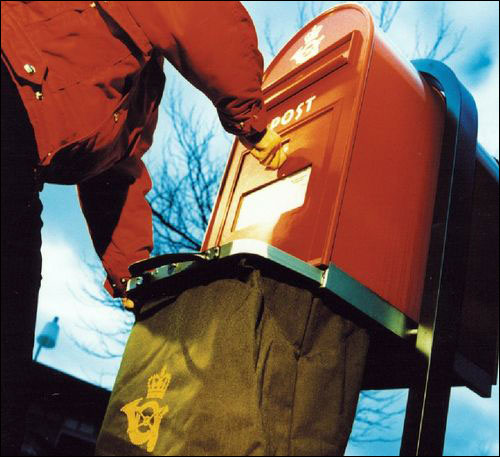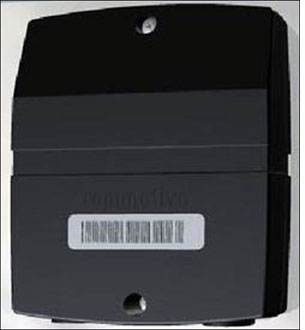Danish postal operator Post Danmark—a branch of PostNord, which provides national postal services to Denmark and Sweden—is employing an RFID system that tracks the movements of postal vehicles and the emptying of mailboxes throughout the entire country, via transponders that both transmit and receive data upon coming within read range of each other. With the solution, provided by Danish startup Commotive, PostNord has been able to improve the accuracy of its pickup times at each mailbox, as well as optimize carrier routes and reduce the need for carriers and vehicles, according to Christian Østergaard, PostNord’s head of business information and production alignment.
For about the past seven years, PostNord has been utilizing active RFID tags to track the movements of roll containers throughout Denmark. Since the agency first began using the technology to better manage those assets’ locations, Østergaard says, it has eliminated the problem of missing roll containers (see Post Danmark to Tag its Roll Cages). In fact, he states, “we’re drowning in carts now.”

Approximately two years ago, Commotive approached Post Danmark with a solution that it promised would be less expense than one involving traditional active RFID tags and readers. A Commotive tag not only transmits a unique ID number and other information stored within its memory, but can also serve as a reader, and thereby receive data transmitted by other Commotive transponders.
Post Danmark was interested in using the technology to track its carrier routes throughout the nation. So in early 2011, the postal operator attached Commotive Z1 battery-operated 2.4 GHz transponders—which measure 80 millimeters by 95 millimeters by 25 millimeters (3.1 inches 3.7 by inches by 1 inch)—to the interior of the locked hatch of each of 7,700 public mailboxes. The organization also attached a Commotive Z3 tag (which comes with a built-in GPS unit) under the hood of each of its 3,800 carrier vehicles, wired to each vehicle’s battery for power. Finally, the operator installed Commotive Z4 readers, with a wired connection to the server at the entrance of 400 Post Danmark buildings at which mail picked up from mailboxes is delivered to be sorted and shipped to other locations. All of Commotive’s devices operate at 2.4 GHz, employing a proprietary air-interface protocol based on the IEEE 802.15.4 standard.
With the system in place, each mailbox’s Z1 tag utilizes a sensor that detect the opening of the hatch at the front of the mailbox, thereby indicating that the box is being accessed by a mail carrier. Every time this occurs, the tag stores that event in its 250 kilobits of memory, and also stores the ID numbers and GPS coordinates of the Z3 vehicle tags that have passed within its read range, as well as related timestamps. The Z1 transponder transmits all that data whenever its mailbox’s door is opened, and whenever it detects a transmission from a Z3 tag of a passing postal carrier vehicle. The read range for Commotive’s system is 100 meters to 200 meters (328 feet to 656 feet).
When a carrier vehicle returns to or merely passes any of the PostNord buildings, Z4 readers mounted on the facilities’ walls download all data from that vehicle’s Z3 tag. The devices then forward that information to the server via a wired connection, thereby updating information regarding where the vehicle has been (based on GPS data), as well as which mailboxes it passed, which ones the driver opened and when this occurred.
PostNord has been using this data to improve its carrier pickup times. For example, a specific pickup time is displayed on every mailbox, and the software data lists when the pickup actually occurred, thus enabling the agency to identify when pickup times are off-schedule. What’s more, the organization can utilize the RFID and GPS data to improve its carrier routes, by analyzing how long it takes to reach each box, the route taken and any conditions (such as traffic or weather) that might create delays.
Although that data is currently only being reviewed by PostNord’s management, Østergaard says, the operator hopes in the future to make this information available to the public, so that individuals can see exactly when carriers have emptied specific mail boxes. During the year since the system’s installation, Post Danmark has modified its mail-collecting procedures, based on the RFID data collected. As a result of these modifications, Østergaard says, pickup time accuracy is now above 99 percent. “We’ve become very precise,” he states. “We had a pretty high quality [tracking accuracy] before as well, but we had a hard time proving it. We estimate that we have improved our overall [mailbox] collection quality by 0.5 percent.” An improvement by half a percentage point, he says, “is a lot at that level.”
Once the system was installed, PostNord identified other business cases for the technology. The tracking of the vehicles’ movements—based on GPS data stored on the Commotive transponders—has enabled Post Danmark to research which vehicles are in use more than others, which remain inactive, or in what cases several vehicles are being operated along the same route when only one would suffice. In that way, Østergaard says, the operator has reduced its fleet of vehicles by 350 vehicles—or about 10 percent.
The technology also provided an unexpected benefit: When a mailbox was stolen, the Commotive technology enabled PostNord’s staff to locate it the following day, within a wooded area beside a country road. Because the mailbox’s Z1 tag continued transmitting whenever it detected a signal emitted by a passing postal vehicle’s Z3 tag, it transmitted its ID number to that vehicle’s tag, and at the end of the day, once that information was retrieved in the server, the agency was able to determine the mailbox’s precise location, based on those transmissions and GPS data from the vehicle’s tag. Based on this event, Østergaard says, the operator is now considering offering a finding service to other companies or individuals looking to tag their assets with Commotive tags for locating purposes. Because carrier vehicles cover so much territory within Denmark, they would eventually be expected to read that tag ID, at which time PostNord could report the location to the asset’s owner. Such a system, however, is currently only at the discussion stage.
According to Østergaard, PostNord is presently testing a solution in Sweden, supplied by Lyngsoe Systems (the same company that is providing RFID technology for tracking roll containers throughout Denmark), involving the use of active RFID tags and readers to track the timeliness with which mailboxes are emptied in a small area of that country. However, he notes, the postal operator has not yet chosen to expand the system throughout Sweden, and PostNord has yet to decide which solution to deploy.
When it comes to the rolling containers being tracked via Lyngsoe’s active RFID tags, readers and exciters, Østergaard says, the tag batteries are beginning to reach the end of their lifespan, and the operator will soon need to decide whether to continue using that technology on the cages, which would require replacing the batteries, or replacing the tags with another technology, such as Commotive’s solution. The battery life of a Z1 tag’s four AA batteries is typically two years, he says. The battery status of Z1 tags attached to mailboxes is collected by the Z3 tags of passing postal vehicles, in order to determine which batteries may be running low.



